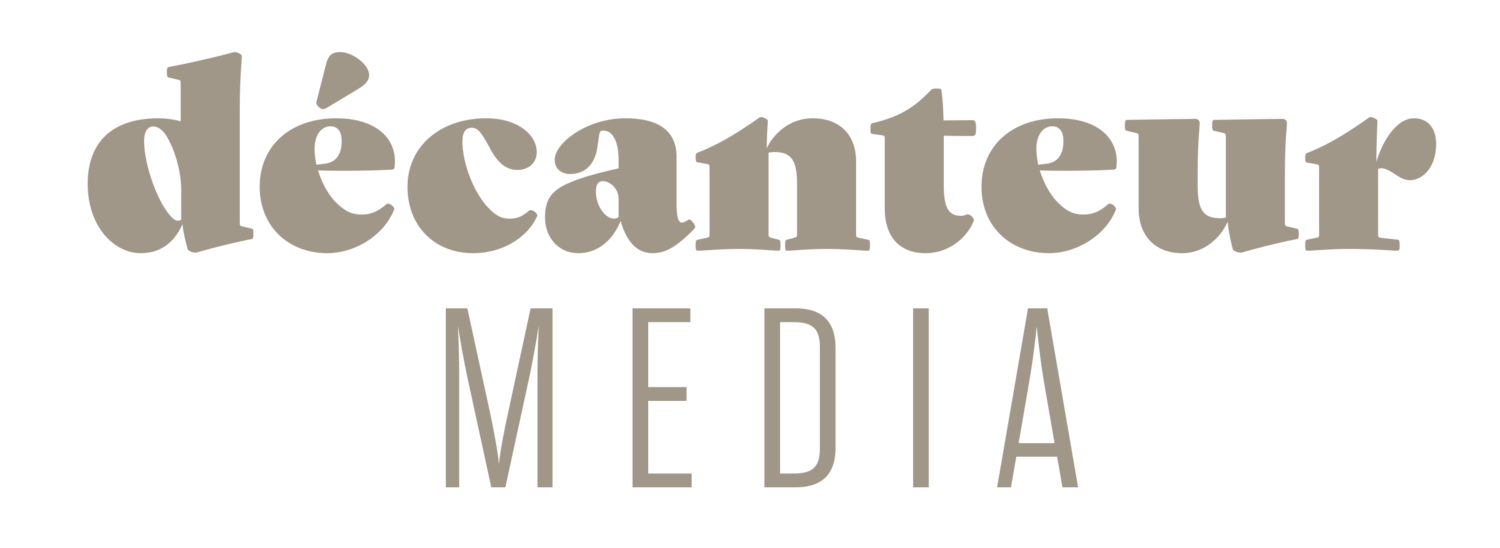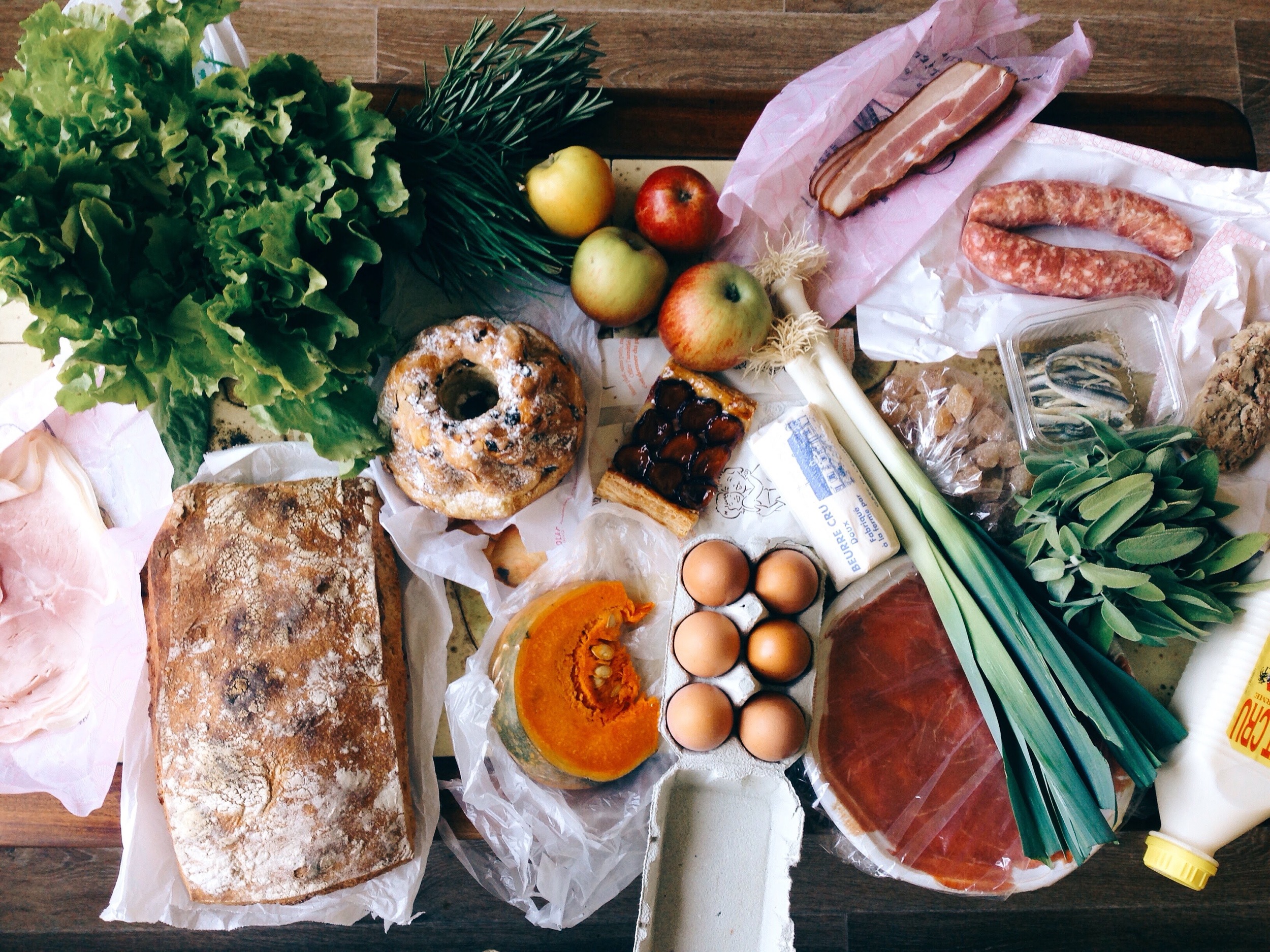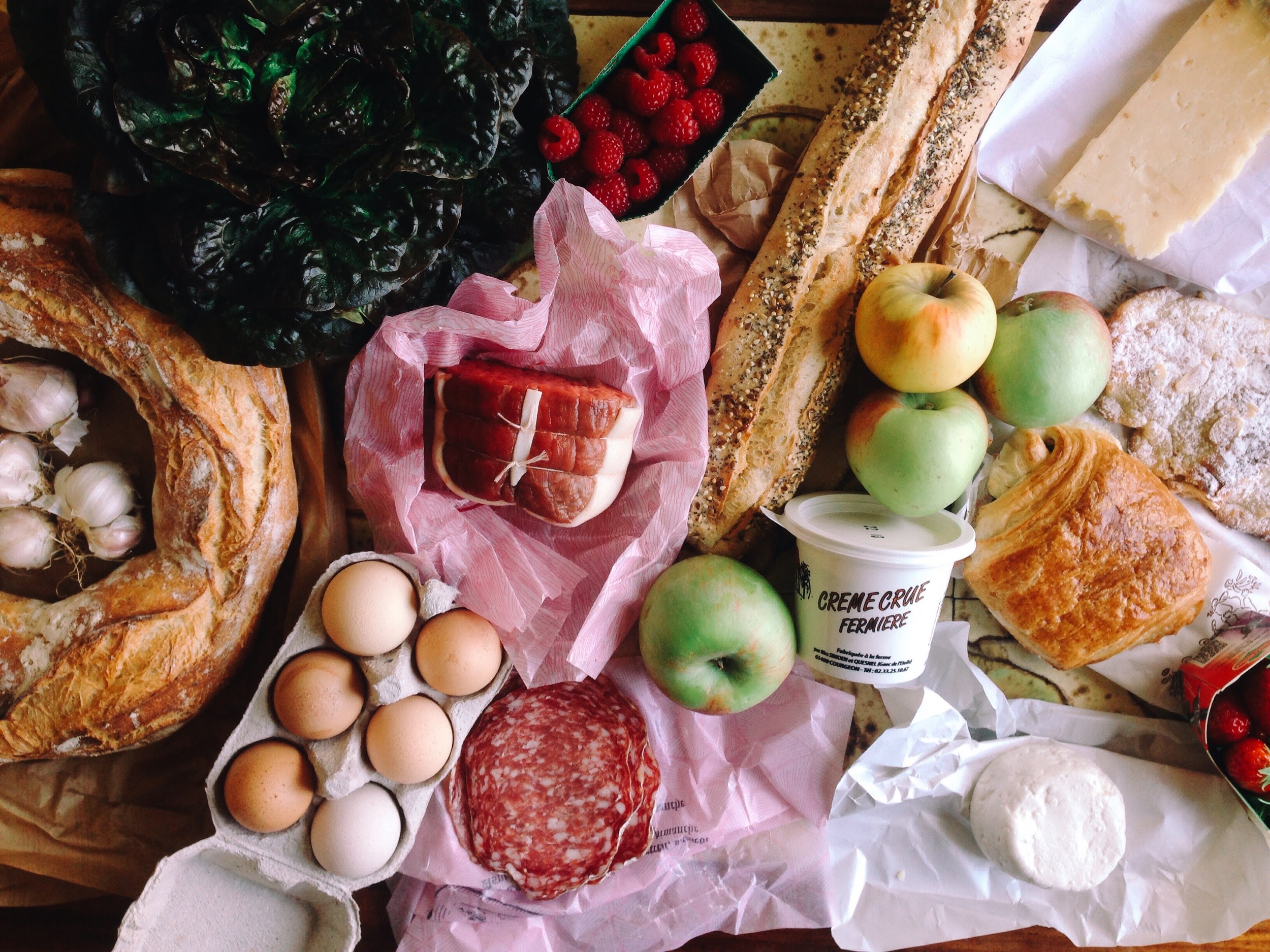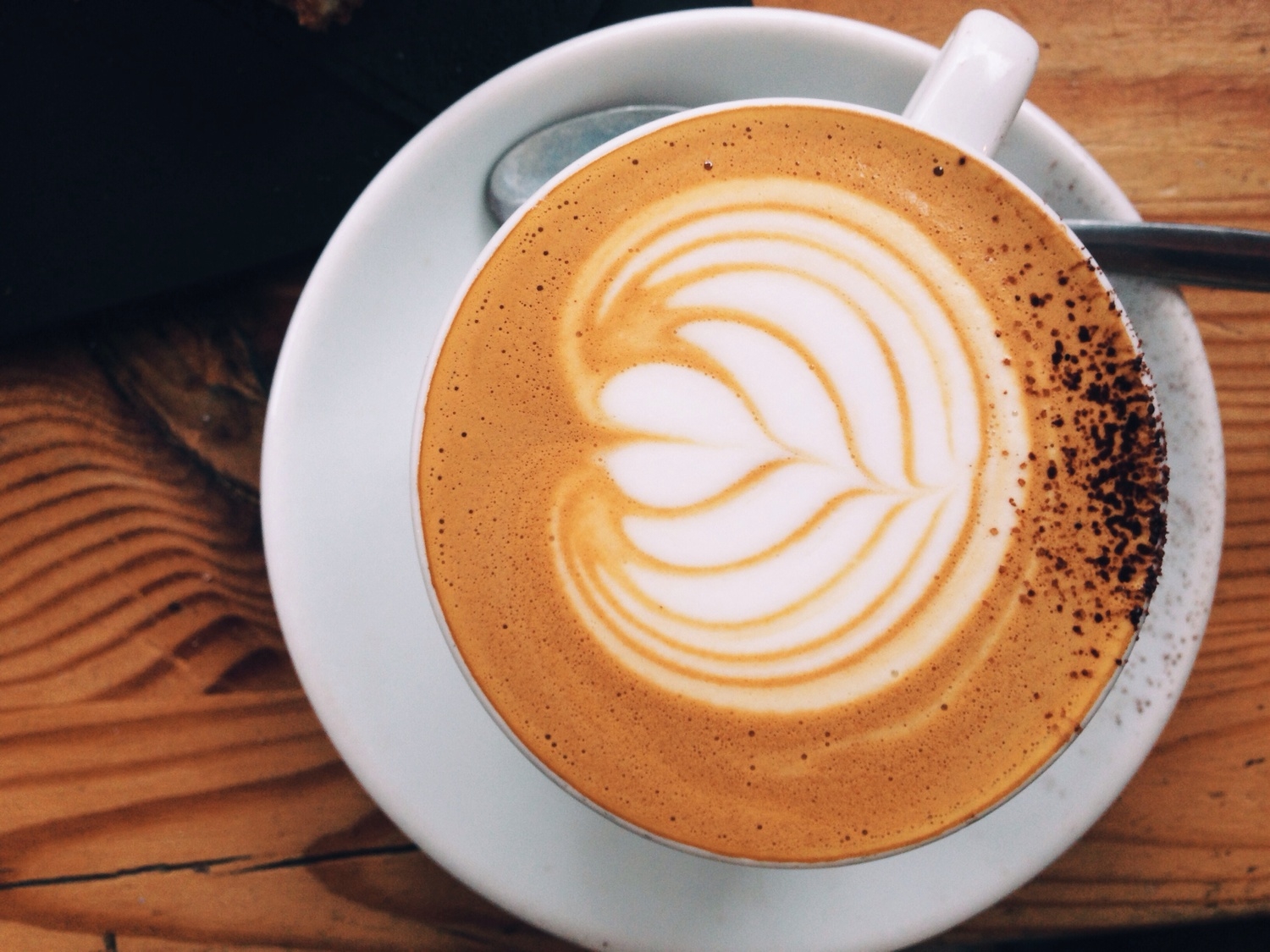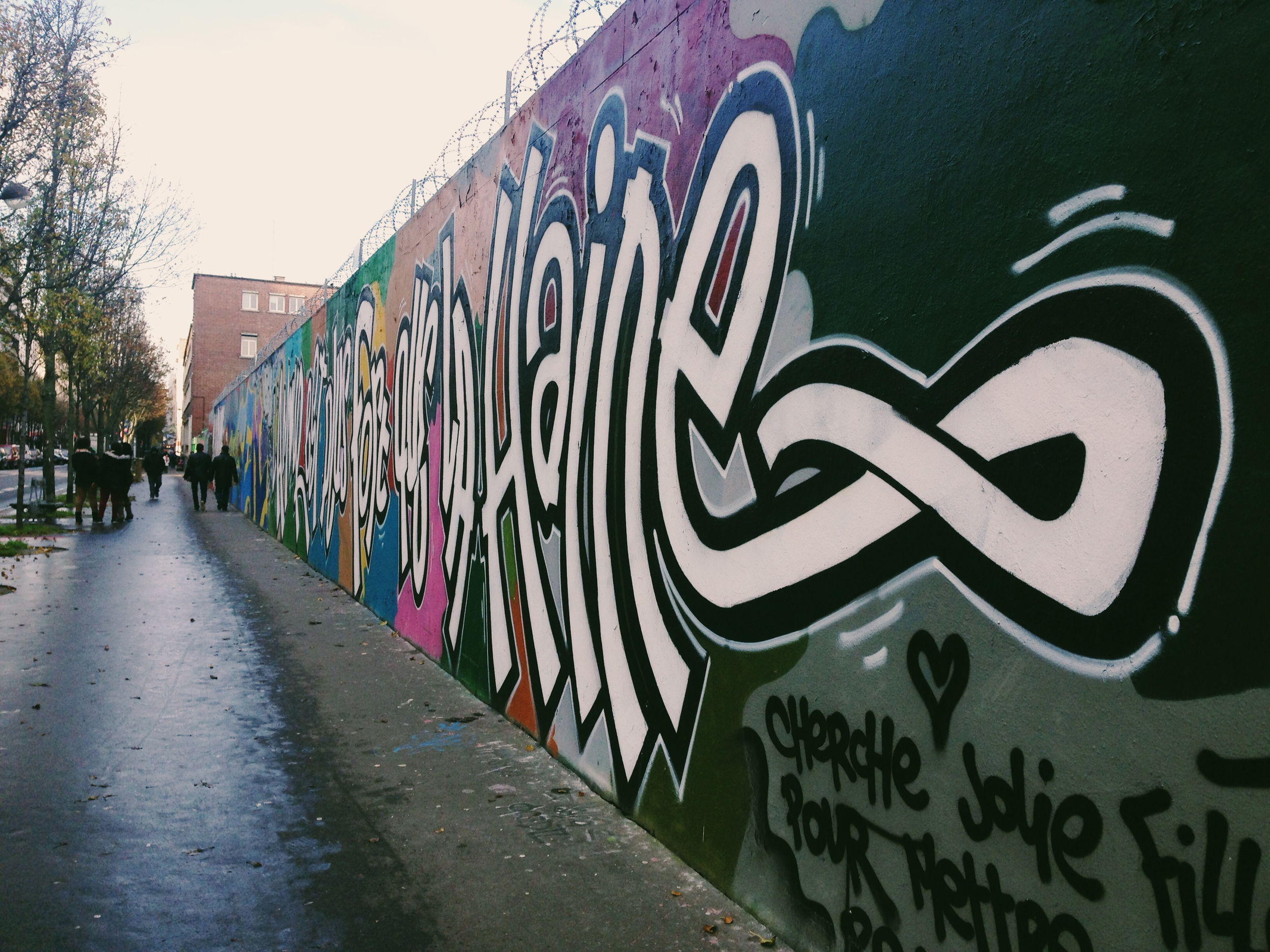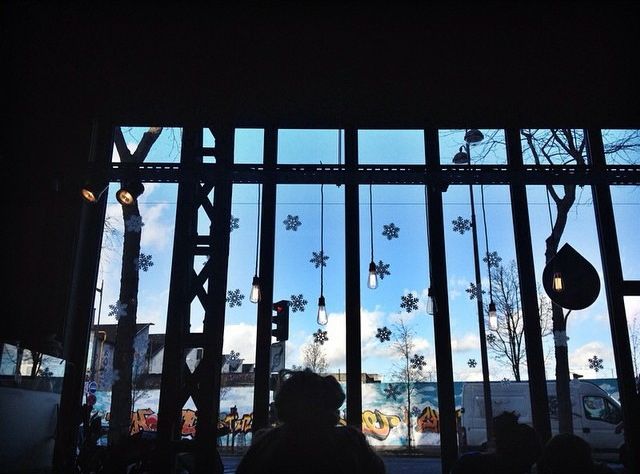Sunday is my favorite day of the week, because Sunday is market day. I roll out of bed, throw on jeans and my black Adidas, maneuver my bike into the elevator and start pedaling towards the Mairie d’Asnieres, where the covered market is held every Thursday and Sunday morning. As a foreigner living in Paris, I’ve discovered that developing routines and rhythms is the easiest way to carve out a home for myself here. In a place where I have absolutely no point of reference, creating my own habits is what anchors me. My market ritual is something sacred, my form of Sunday worship, and my week just doesn’t feel complete without it. The infatuation I have with the Sunday market is partly because of the beautiful bounty of French food. I crave the smells and sounds of the market - whole chickens roasting on spits outside under tents, the choucroute steaming in silver pans, a kaleidascope display of French cheeses in all shapes, sizes, and colors; huge chunks of ruby red beef being hacked into pieces by the butcher; whole rabbits stretched out on their backs, pig heads with gaping toothless mouths and empty eye sockets; chickens with limp necks and open beaks; bread stacked nearly to the ceiling; vegetables tumbling from tables, young men with stubble cutting apples and oranges and avocados to tempt customers into buying. The rush and crush of the market is exhilarating, the array of fantastic foods is mouth-watering, the juxtaposition of oddities and delights so intriguing you never want to look away. It is because of this market that I know I’m ruined for life when it comes to butter, fresh goat cheese, and terrines. I crave the raw milk, small farm eggs still plastered with little downy feathers, fresh cuts of meat and an endless variety of cheeses. I’ll never be able to find such a distinct collection of delicacies in the U.S. because they have long ago died out and been reborn as expensive, artisanal, pretentious expressions of their original selves. But the market holds such a special place in my heart for more than just the food - it’s also about the people. It’s a way for me to connect with a community in which I often feel an outsider, a way to give myself context and feel belonging. Over food, people connect in a way that is entirely unique and quickly intimate. I look forward to this feeling of connection, to seeing the people that have developed into something closer to a friend than a vendor. And the reason why the market facilitates this kind of bond is because, unlike a clerk or cashier, these people are deeply embedded in the food they are selling. The goat cheese man who always makes sure to ask me how I am and noticed as my accent smoothed out makes the fresh goat cheese with his own hands, and drives from his farm every weekend to sell it. The man who carves off slices of pumpkin for me and chooses the crispest apples has hands crusted in dirt from working in the field. The guy who sells me bread and loves to practice his English with me has flour on his face from a morning of baking. These are the people who care about food, and when you care too, a kind of closeness is born. The market is how I orient myself in a world that I often feel lost in. It’s how I carve out a sense of belonging, create a home in a foreign place, and connect with those who understand this place to its roots.
Brunch in Belleville
Each neighborhood in Paris is distinctly unique. Each has a different array of characteristics that make up a certain personality, a feeling you absorb when you are in them. Belleville is one of my favorite neighborhoods in Paris, not least because of how distinctly different it feels. Hard to get to, tucked up in the northeast corner of Paris, Belleville is one of those neighborhoods that manages to escape the Parisian cliché. It has a vibrant, bustling culture of its own that stands out against the Parisian standard without being in opposition to it. It is filled with wandering hilly streets, clean white buildings, Tunisian coffee shops, oriental patisseries, graffiti and modern architecture. It’s almost refreshing, being faced with such different smells and sights and streets and buildings. The typical crowds of Paris are nowhere to be found, and even on cloudy days it feels filled with a blanched sunniness that comes along with the calm of sitting a bit to the side of the heart of Paris.
The jewel of Belleville is the Parc de Belleville, which looks down over the entire city in a sweeping vista similar to that of Sacre Coeur, but with fewer tourists and a better view of the Eiffel Tower. There is a little boulangerie with decent breads and pastries, and a sidewalk café that serves a decent Sunday brunch. Paris has changed my definition of “brunch” fundamentally. On the west coast, “brunch” sort of just means breakfast is served all day, with alcohol. On the east coast, “brunch” is a more expensive breakfast served all day, with alcohol. In Paris, brunch is a fixed price (usually around 20 euros) for a big plate filled with a variety of small dishes - usually different breads or pastries with spreads and confitures, meats and patés, cheeses, vegetables, fruits, juices, and coffee. It’s really like your own personal buffet platter, and it’s glorious
This past weekend was one of those last few with weather beautiful enough to send Parisians scurrying outside to soak up the last of the sunshine. The Parc de Belleville was filled with picnicking Parisians looking down on the city splayed below, swaying awkwardly to some kind of alternative DJ playing in the square above the park. I met a friend for a beautiful long brunch outside on the terrasse of Moncoeur Bistrot, the café at the top of the hill by the park. The “Moncoeur brunch” was a big plate filled with soft scrambled eggs, ham, fromage blanc with honey and walnuts, Comté cheese (my absolute favorite), a carrot and spinach salad, mixed fruit cup, a slice of carrot cake and a little chunk of dark chocolate fudge cake. We ate and talked and enjoyed the warm sun and cool breeze on a terrasse filled with happy Parisians saying goodbye to summer, settling into fall.
Italian Imports & Spaghetti alla Carbonara
One of the benefits of going to a grad school in a European city is meeting people from all over the world. I've met a German, a Swede, a Turk, a Jordanian, a Syrian, a Brazilian, a Croatian, an Australian, a Grecian, and an Italian. And sometimes, if you're lucky, one of these new international friends will bring you some treats from their home country.
My friend Violetta is from Turin, just under two hours west of Milan. More interesting to a food lover like me, Turin is located an hour north of Bra, the birthplace of Carlo Petrini and the Slow Food Movement, and current location of the University of Gastronomic Sciences. Read: there is very good food here. And I don't just mean delicious, as all Italian food purports to be with your usual pizza pasta stereotype. I'm talking about some of the most beautifully cultivated produce, hand-crafted products, and carefully tended animals, all of which is heralded as local above all else. Local isn't exactly a fad for Italy, it's a tradition. Violetta told me about the idea of "Zero KM," which is a label applied to products and ingredients designating their locality. Knowing my love for food (especially good food), Violetta had her mother bring me a couple pastas and a bruschetta from her hometown, which I used to make an absolutely amazing Italian feast in Paris.
On the menu: bruschetta, spaghetti alla carbonara, and chardonnay from Macon Valley in the Borgogne region of France.
That morning, I went to the market and picked up some good, crusty bread for the bruschetta (which was incredible and had unexpected olives in it) and some lard fumé, which may sound disgusting (smoked fat? really?) but is actually a much more accurate (and graphic) name for smoked bacon. This was to use in place of the traditional guanciale, which I could not find or just didn't translate to the French meat offerings. I chose to do a carbonara because I wanted to do something simple and not too overpowering in order to fully appreciate the pasta. Carbonara was perfect, because it added a slight accent to the pasta without completely hiding it. I was also intrigued by the term "chittara," which is the name of the machine used to make this particular type of spaghetti, and also contains egg.
Spaghetti alla carbonara is really quite simple. Pasta, parmesan, egg, pepper, and guanciale (or in this case, bacon). And it hits the perfect spot between refined and homey. With the thicker egg noodles, the yolk-sauce really coated the pasta and made for a wonderfully rich bite, lightly peppered, coated in parmigiano-reggiano, and studded with bacon. The white wine didn't hurt, of course - what with my recent wine-tasting adventure and a documentary I saw called A Year in Burgundy, I've been a bit obsessed with Burgundy wines, chardonnay and pinot noir to be specific.
SPAGHETTI ALLA CARBONARA (for two)
Ingredients:
- Spaghetti (about 250g)
- Olive oil (2-3 tbsp)
- Guanciale (or pancetta, bacon, any salted pork meat really)
- Cracked black pepper
- Parmigiano-reggiano
- 2 egg yolks (one for each dish)
- Salt, to taste
Method:
While pasta cooks, sauté bacon in a separate pan. Drain pasta and mix in olive oil, bacon, cracked black pepper, and parmigiano-reggiano. Separate into serving dishes, and individually mix in egg yolk to each. Top with salt to taste, and more parmesan or cracked pepper if necessary.
Finding Good Coffee in Paris
The clichéd Parisian café. Accordion music play in the background as you idle away an hour or two, people-watching or reading some sort of literature (probably Hemingway), nursing a tiny espresso or equally tiny glass of wine, basking in the glory that is Paris and the luxury of wasting time in it. While this is all wonderful, finals week during grad school has eliminated such luxury for me, and sent me roaming the city in search of a more laptop-friendly café. And to be honest, Paris has a bit of a problem with those tiny espressos: they are usually really not very good (here's a blog post that explains why). So I took to the Internet, and found the following two beautiful little cafés that serve a variety of high-quality imported coffee, lattes (which the French have decided just don't exist), salads, soups, and baked goods (including chocolate cake!), and feature free WiFi and outlets for laptops.
53 Avenue Trudaine, 9éme
Situated on the corner of a cute little square overlooking the Rue des Martyrs, KB Cafeshop serves amazing coffee (including the gorgeous latte art creation at the top of this post) along with scones, cookies, sandwiches, salads, soups, and even smoothies and juice. That's right, juice has hit Paris.
The thing I love about KB though is the bar along the window that overlooks the square (which happens to be quite festive at the moment). Power strips galore, the bar is the perfect place to park your laptop and get some work done while sipping a gorgeously large latte or artisan drip coffee and munching on an apricot scone or 6€ carrot soup. I spent six hours here today (a Saturday) and the place never got too crowded or loud to work, although in the moments when I looked up from my work to take a people-watching break several different languages (including English) washed over me.
3 ter Rue Marcadet, 18éme
Café Lomi is tucked on the other side of Montmartre, in a hidden part of the eighteenth arrondissement that's slowly becoming one of my favorite Parisian spots. It might be a bit out of the way, but it's worth it for the view of a very different Paris than the clichéd romantic Eiffel Tower version. True to the broken cliché, Café Lomi doesn't fall into the traditional Parisian Café category. It's got sort of a warehouse feel, with a big, beautiful open interior, industrial chic lighting, and even a communal table. Definitely a spot for coffee nerds, the coffee menu offers several different types of beans and brew methods to choose from. And on a misguided search for the bathroom, I accidentally stumbled into the storeroom (much to the horror of the guy working there) and was faced with bags upon bags of beautiful, rich imported coffee...so I know for a fact they're not lying when they say it comes from Kenya. Or Colombia. Or Ethiopia.
They also have an incredible 8.50€ soup/salad combo, a delicious chocolate cake, free (fast!) WiFi, and a view of this really cool graffiti mural on the barbed-wire topped wall across the street...which may or may not house a previous nuclear site, war camp, or factory (the most likely but also the least imaginative).
So until I am freed from the grad school finals burden burying me in 20 pages of unwritten papers, you can find me at either one of these study-spots sipping a beautifully-foamed latte and slurping on winter soup.
Foire des vins
Fall means many things in France - leaves changing color, roasted chestnuts instead of roasted maize (thankfully, since roasted maize really smells awful), scarves as permanent outfit fixtures, and the harvest of new wines. This last one is my favorite; it results in tastings and fairs popping up all throughout Paris, including one just fifteen minutes from our apartment that featured over 50 producers of wine and artisanal food products (foie gras, sausage, cheese, chocolate, oysters, etc) and endless free tastings.
Growing up in Marin County, I'm no stranger to farmer's markets and food festivals. But the variety of markets and fairs we have there is distinctly elitist and yuppie, a specific statement about a facet of society that values farm-to-table as a trend and a social movement. In France, the celebration of agricultural products and wines is just a way of life, historically ingrained in the culture. It feels authentic, especially when you realize some of these vineyards date back to a time before America even existed. The distinct nature of the products at the fair was local, artisanal, and handmade. The producers wanted to talk to us, even across a difficult language barrier, about their products - how they were made, why they tasted in a certain way, where they were located. We were invited to help with next year's harvest, offered to taste as much as we wanted, given advice on what to pair with what. And as a result, we came away with considerably lighter wallets and considerably heavier bags - six bottles of wine, a wedge of Brebis cheese, nine sausages, a handful of macarons, and five meat hand pies. It's not just food. It's a celebration of life, and ways of life, that are distinctly French.
